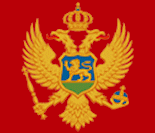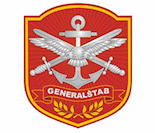Military of Montenegro (Vojska Crne Gore)
 With the separation from Serbia in 2006, Montenegro inherited trained and disciplined in-place ground and naval forces. Their goal is to transform these units into a NATO-compatible force consisting of a light infantry brigade, a helicopter-based air force and a navy capable of coastal patrolling, search and rescue (SAR), and counter-terror operations.
With the separation from Serbia in 2006, Montenegro inherited trained and disciplined in-place ground and naval forces. Their goal is to transform these units into a NATO-compatible force consisting of a light infantry brigade, a helicopter-based air force and a navy capable of coastal patrolling, search and rescue (SAR), and counter-terror operations.
According to the government's adviser for security, Radosav Martinovic, the AoM will remain small, professional, integrated within the collective security systems of the region. It was intended to maintain an economically viable force with an objective strength of between 2,500 and 3,000 personnel, including a small rotary wing aviation and a naval coast guard components. By 2010 the AoM was capable of minor military operations on a small scale and faced significant problems due to the stresses of transformation, including limited funds.
The provisions of the Union Agreement stipulated that the Army of Serbia-Montenegro (Vojska Srbije i Crne Gore - VSCG) was to be split in such a way that assets in the territory of each country are retained. At the time of the split, the VSCG was itself in the midst of a wide-scale reduction and reorganisation of forces, so that what had once been an army Corps with over fifteen brigades in Montenegro five years earlier, had already collapsed to a few under-strength shadow brigades with a motley collection of mostly aged weapons and equipment and an extensive, deteriorating inventory of barracks and other facilities.
The Defence structures in Montenegro needed to be further developed and adapted to the new strategic environment based on the defined national interests and goals. The ongoing defense reform therefore includes a series of reforms targeted towards overall defence institution building whit an ultimate aim to join Euro-Atlantic structures. The main goal of defense reform is establishment of entirely new, stable, functional, and reliable security system which will be able to meet the challenges, risks and national security threats as well as to contribute to peace and stability on the regional as well as global level. In this process, Montenegro follows principles adopted by mature democracies and respect for international law and agreements.
The Law on the Armed Forces of Montenegro, was passed by the Assembly of Montenegro at the 24. convening, at the eight session of the second regular sitting in 2009, on 23 December 2009. This law regulates the organization of the Armed Forces of Montenegro, military service, rights and obligations and the status of persons in the Armed Forces during the service and other issues of importance to the Armed Forces.
The Armed Forces are a professional defence force that defends the independence, sovereignty and national territory of Montenegro, in accordance with the principles of international law regarding the use of force and shall carry out assigned missions and tasks. The Armed Forces are under parliamentary supervision and democratic and civilian control, in accordance with the Constitution and the law. The Armed Forces are organized into commands and units. The Armed Forces are composed of services, branches and combat service support. Armed Forces services are the Army, Air Force and Navy [other sources reference the Air Force Base and the Army Brigade of the Armed Forces of Montenegro]. The Government of Montenegro shall prescribe branches and combat service support.
The Armed Forces are composed of active and reserve forces. Active Armed Forces consist of military personnel and civilians in service in the Armed Forces. Reserve personnel of the Armed Forces represent active and inactive reserve. Size, composition and active Armed Forces Reserve engagement are prescribed by the Government regulation. Military personnel are professional military personnel, soldiers in training and reserve forces while being in service in the Armed Forces. Persons enlisted into the Armed Forces are professional military personnel and civilians employed in the Armed Forces. Military personnel are contract soldiers; non-commissioned officers (NCOs) and contract non-commissioned officers; officers and contract officers.
Mobilization of the Armed Forces shall be declared in the state of war and emergency. During mobilization, the Armed Forces shall move from peace organization and the state into war organization and the state of readiness for defensive operations, according to the Armed Forces Mobilization Plan. Mobilization of the Armed Forces, concerning their size may be general or partial, and related to the method of operation, it may be public or secret. General mobilization of the Armed Forces shall include all commands and units, and a partial mobilization of the Armed Forces only individual commands and units.
 Preparation for the Armed Forces engagement are done by the General Staff of the Armed Forces as the organizational unit of the Ministry. Organization of the work of the General Staff and command in the General Staff are done by the Chief of Defence. All the Armed Forces commands and units are subordinated to the Chief of Defence. The Chief of Defence is responsible to the Minister for the situation within the Armed Forces. The Chief of Defence is a professional officer, appointed and discharged by the Defence and Security Council. Carrying out acts related to command over the Armed Forces, the Chief of Defence shall pass orders, ordinances, instructions and other acts.
Preparation for the Armed Forces engagement are done by the General Staff of the Armed Forces as the organizational unit of the Ministry. Organization of the work of the General Staff and command in the General Staff are done by the Chief of Defence. All the Armed Forces commands and units are subordinated to the Chief of Defence. The Chief of Defence is responsible to the Minister for the situation within the Armed Forces. The Chief of Defence is a professional officer, appointed and discharged by the Defence and Security Council. Carrying out acts related to command over the Armed Forces, the Chief of Defence shall pass orders, ordinances, instructions and other acts.
The Army consists of components, branches and services. Components are not in classical terms independent organisational units, but they rather complement each other through joint functions and services, maintaining at the same time main features of the components (land forces, navy and air force). Branches have common main armaments and equipment, while organisation, training and purpose are different. Services have specific organisation, equipment and training required for implementation of the activities of combat support. Therefore, they can be general and logistic services. Branches and services may have types and specialities. Branches and services are stipulated by the Government of Montenegro. At all levels of organisation of the Army and because of specific security and defence requirements of Montenegro, branches and services can be combined in permanent or temporary task forces.
|
NEWSLETTER
|
| Join the GlobalSecurity.org mailing list |
|
|
|

